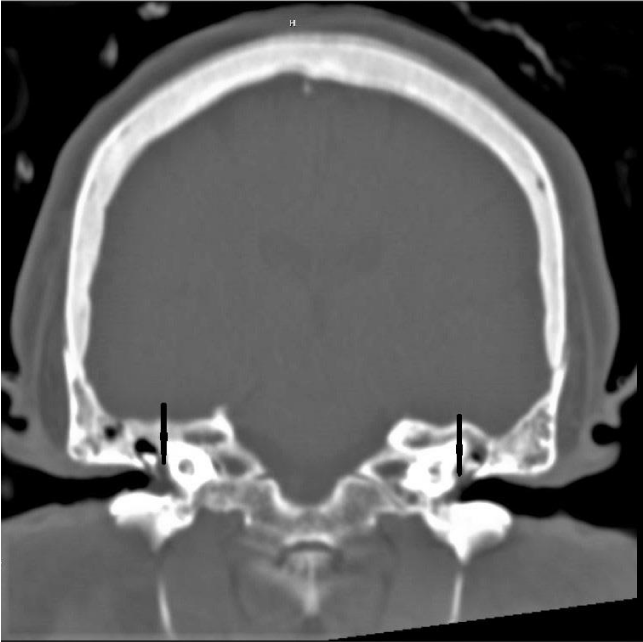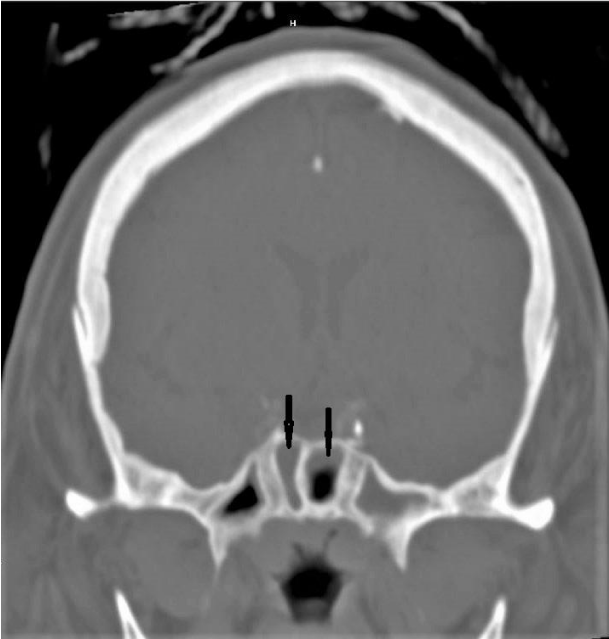Archives of Otolaryngology and Rhinology
Recent Hearing Loss and Earache due to Bilateral Otitis Media associated with SARS-CoV-2 infection
Sahrish Ilyas1 and Samba Siva R Bathula2*
2Department of Otolaryngology, Detroit Medical Center, Michigan State University, Detroit MI, USA
Cite this as
Ilyas S, Samba Siva RB (2020) Recent Hearing Loss and Earache due to Bilateral Otitis Media associated with SARS-CoV-2 infection. Arch Otolaryngol Rhinol 6(4): 111-113. DOI: 10.17352/2455-1759.000135Background: Since the outbreak began in late December 2019, COVID-19 has been declared a global pandemic, with over 3 million cases reported worldwide. COVID-19 is known to present commonly with symptoms such as fever, cough, shortness of breath, myalgias, loss of sense of taste and smell. Otalgia and hearing loss have been reported very rarely. We present a case of upper respiratory tract infection with involvement of the sinuses and middle ear secondary to SARS-CoV-2 infection.
Case report: A 69-year-old woman presented with fever, productive cough, bilateral earache, and diminished hearing for 5 days prior to admission. On examination, her temperature was 38.2 C, respirations 22/min, pulse rate 112/min, with O2 saturation of 96%. Otoscopy revealed erythema and opacification of the left tympanic membrane suggestive of otitis media. SARS-CoV-2 infection was confirmed by reverse transcription-polymerase chain reaction (RT-PCR) testing from nasopharyngeal swab. Chest x-ray revealed vascular congestion but no parenchymal opacities. A diagnosis of upper respiratory infection due to SARS-CoV-2 involving the sphenoid sinus and both middle ears was made based on head CT scan.
Conclusion: COVID-19 most commonly presents with fever and respiratory symptoms, including cough, shortness of breath, anosmia, hyposmia, dysgeusia and sore throat. Involvement of the ear and sinuses from upper respiratory tract infection with SARS-CoV-2 has been previously reported in very limited case reports. We are presenting this case because we believe these findings should possibly alert clinicians to suspect SARS-CoV-2 infection and take proper protective measures to prevent the spread of infection.
Introduction
Since the outbreak began in late December 2019, coronavirus disease 2019 (COVID-19) due to severe acute respiratory syndrome coronavirus 2 (SARS-CoV-2) was declared a global pandemic by the World Health Organization (WHO) on March 11,2020, with over 3 million cases reported worldwide [1]. The novel coronavirus is closely related to the previous Severe Acute Respiratory Syndrome (SARS) coronavirus epidemic in China in 2002 and the Middle East Respiratory Syndrome (MERS) in 2012 in Saudi Arabia [2,3]. Prior coronavirus epidemics in 2002 and 2012 presented with predominantly with lower respiratory tract symptoms such as cough, shortness of breath and fever and could progress rapidly to acute respiratory distress syndrome (ARDS). SARS-CoV-2 infection has been found to present commonly with both lower respiratory tract symptoms such as fever, cough, shortness of breath, ARDS as well as upper respiratory tract symptoms such as loss of sense of taste and smell [4]. Otalgia and hearing loss have been reported very rarely [5]. We present a case of upper respiratory tract infection with involvement of the sinuses and middle ear secondary COVID-19 infection due to SARS-CoV-2.
Case report
A 69-year-old woman with chronic obstructive pulmonary disease on supplemental oxygen, hypertrophic obstructive cardiomyopathy with a defibrillator in place, end stage renal disease on hemodialysis, presented with fever, productive cough, bilateral earache, and diminished hearing for 5 days prior to admission. On examination, her temperature was 38.2C, respirations 22/min, pulse rate 112/min, with O2 saturation of 96% on 3 L of oxygen via nasal cannula. Otoscopy revealed erythema and opacification of the left tympanic membrane suggestive of otitis media, and keratinaceous debris in the right external auditory canal .Bedside hearing evaluation showed bilateral conductive hearing loss. Laboratory data revealed lymphocytopenia and neutrophilia with elevated inflammatory markers (CRP, LDH, d-dimer). A nasopharyngeal swab for severe acute respiratory syndrome coronavirus 2 (SARS-CoV-2) by reverse transcription polymerase chain reaction (RT-PCR) .Chest x-ray revealed vascular congestion but no parenchymal opacities. Computed tomography (CT) of the head revealed fluid in both middle ears and the sphenoid sinus (Figures 1 & 2). A diagnosis of upper respiratory infection due to SARS-CoV-2 involving the sphenoid sinus and both middle ears was made. With supportive care, the patient’s condition improved within a few days and returned to baseline status.
Discussion
Coronavirus disease 2019 (COVID-19) caused by SARS-CoV-2 can present with or without any symptoms [6]. The symptoms, if present, usually include either lower respiratory tract symptoms such as fever, cough, shortness of breath and ARDS and/or upper respiratory tract symptoms such as sore throat, headache, loss of the sense of taste and smell [4,7]. Involvement of the middle ear and sinuses from upper respiratory tract infection with SARS-CoV-2 has been previously reported in a very small number of case reports [5].
Coronavirus disease 2019 (COVID-19) is usually transmitted from person to person through respiratory droplets and human body fluids. The main harboring sites are the nasopharynx and the oropharynx. In our patient, SARS-CoV-2 infection was confirmed by reverse transcription-polymerase chain reaction (RT-PCR) testing from nasopharyngeal swabs.
Viruses commonly cause upper respiratory tract disease inducing an inflammatory response which leads to mucus secretions and ciliary damage to the ciliated columnar epithelium in the middle ear, eustachian tubes and sinuses (8,9) .These events lead to otitis media and sinusitis and are commonly caused by influenza virus, rhinovirus, adenovirus and parainfluenza viruses. Maxillary and ethmoid sinuses are commonly affected in such cases with rare involvement of sphenoidal and frontal sinuses. Frequently, the CT scans of patients are abnormal with viral upper tract infections. Symptoms and radiologic findings spontaneously resolve in most cases. The clinical findings and radiology in the present patient demonstrated that infection due to SARS-CoV-2 can lead to co-infections involving the sinuses and middle ear, similar to other viruses with gradual spontaneous resolution.
Ear, nose and throat examination is considered to be in very close proximity to the mucosal surfaces of the upper aerodigestive tract and thus all medical staff must take the necessary personal protective measures such as N-95 Face mask, face shield and gown and gloves while examining patients suspected of having COVID-19 [10,11].
Conclusion
COVID-19 most commonly presents with fever and respiratory symptoms, including cough, shortness of breath, anosmia, hyposmia, dysgeusia and sore throat. Involvement of the ear and sinuses from upper respiratory tract infection with SARS-CoV-2 has been previously reported in very small number of case reports. We are presenting this case because we believe these findings should possibly alert clinicians to suspect SARS-CoV-2 infection and take proper protective measures to prevent the spread of infection.
1. Authors contributioSahrish Ilyas -Conception and design, Acquisition of data, Analysis and interpretation, , Drafting the article, critical revision and final approval of article, agreement to be accountable for all aspects of the work.
2. Samba Siva R Bathula - Acquisition of data, Analysis and interpretation, critical revision and final approval of article, agreement to be accountable for all aspects of the work.
Funding disclosure
This research did not receive any specific grant from funding agencies in the public, commercial, or not-for-profit sectors.
- World Health Organization (WHO) (2020) Interactive Timeline. Rolling Updates on Coronavirus Disease (COVID-19). Link: https://bit.ly/2UHyMBa
- Drosten C, Günther S, Preiser W, Van Der Werf S, Brodt HR, et al. (2003) Identification of a novel coronavirus in patients with severe acute respiratory syndrome. N Engl J Med 348: 1967-1976. Link: https://bit.ly/36JbdNS
- de Wit E, van Doremalen N, Falzarano D, Munster VJ (2016) SARS and MERS: recent insights into emerging coronaviruses. Nat Rev Microbiol 14: 523.
- El-Anwar MW, Elzayat S, Fouad YA (2020) ENT manifestation in COVID-19 patients. Auris, Nasus, Larynx 47: 559-564. Link: https://bit.ly/35G06pE
- Fidan V (2020) New type of corona virus induced acute otitis media in adult. Am J Otolaryngol 41: 102487. Link: https://bit.ly/38X6ydK
- Cascella M, Rajnik M, Cuomo A, Dulebohn SC, Di Napoli R (2020) Features, Evaluation, and Treatment of Coronavirus. Link: https://bit.ly/2IOUDUS
- Centers for Disease Control and Prevention (CDC) (2019) Coronavirus Disease 2019 (COVID-19). Symptoms. Link: https://bit.ly/35IeJsl
- Massa HM, Lim DJ, Kurono Y, Cripps AW (2015) Middle Ear and Eustachian Tube Mucosal Immunology. In Mucosal Immunology: Fourth Edition 2: 1923-1942. Link: https://bit.ly/3kKpfno
- Kumpitsch C, Koskinen K, Schöpf V, Moissl-Eichinger C (2019) The microbiome of the upper respiratory tract in health and disease. BMC Biol 17 87. Link: https://bit.ly/32ZWdKx
- Anagiotos A, Petrikkos G (2020) Otolaryngology in the COVID-19 pandemic era: the impact on our clinical practice. Eur Arch Otorhinolaryngol. Link: https://bit.ly/2IG0qMA
- Krajewska J, Krajewski W, Zub K, Zatoński T (2020) COVID-19 in otolaryngologist practice: a review of current knowledge. Eur Arch Otorhinolaryngol 277: 1885-1897. Link: https://bit.ly/3fkQ8gI
Article Alerts
Subscribe to our articles alerts and stay tuned.
 This work is licensed under a Creative Commons Attribution 4.0 International License.
This work is licensed under a Creative Commons Attribution 4.0 International License.



 Save to Mendeley
Save to Mendeley
